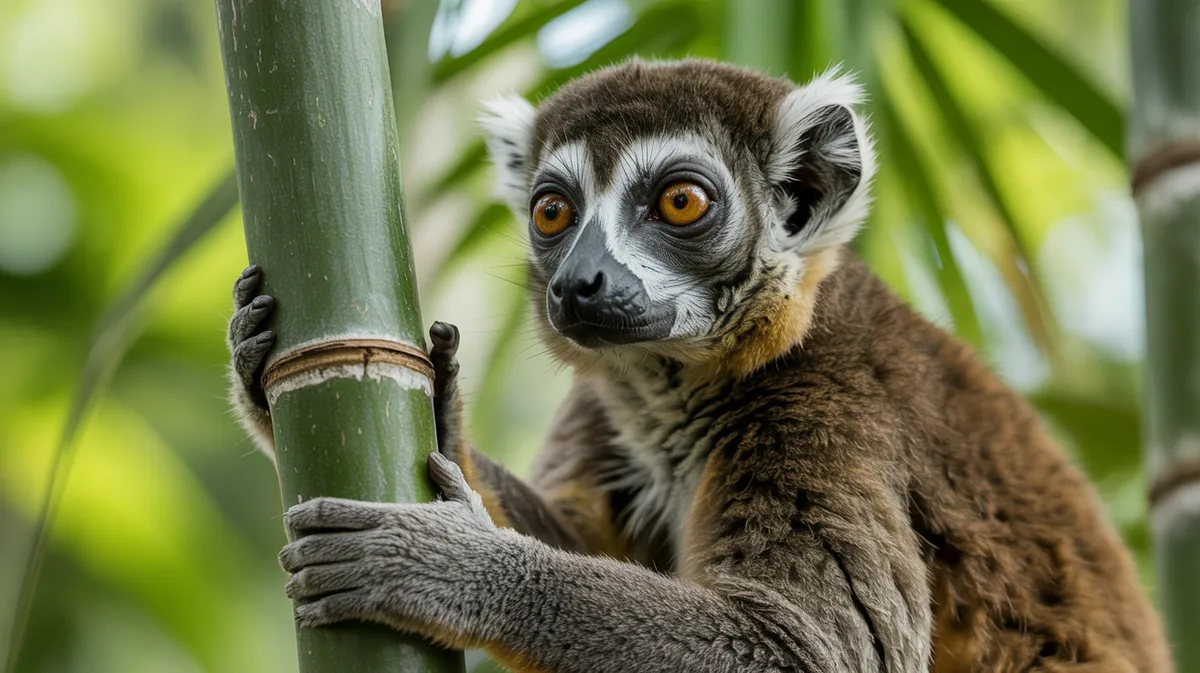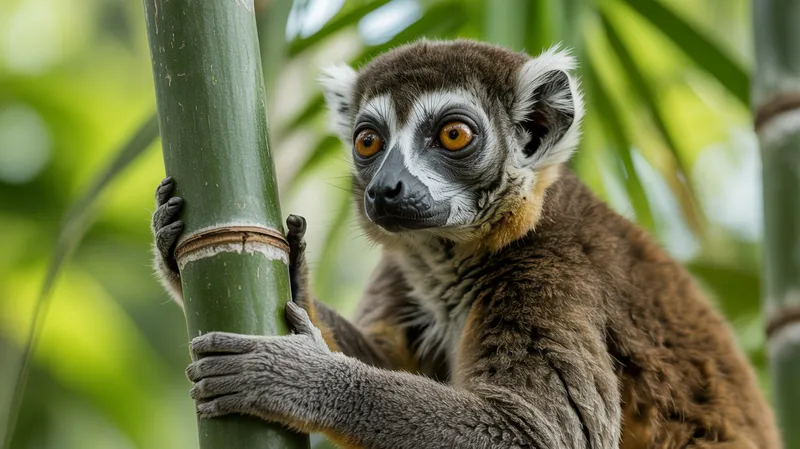
Greater Bamboo Lemur
Prolemur simus

Meet the Greater Bamboo Lemur
The Greater Bamboo Lemur is one of the largest lemurs and is endemic to the rainforests of Madagascar. Distinguished by its robust build, greyish fur, and prominent white ear tufts, this lemur is uniquely adapted to feed almost exclusively on bamboo. It is critically endangered due to habitat loss and its specialized diet, which makes it highly vulnerable to environmental changes. Living in small social groups, the Greater Bamboo Lemur plays a critical role in its ecosystem by dispersing seeds and maintaining bamboo forest health.
Classification
Mammal
Habitat
Tropical rainforest and bamboo forest
Diet
Herbivore
Lifespan
12-17 years
Conservation
Critically Endangered
Weight
2.2-2.5 kg
📖Fascinating Facts
Specialized Bamboo Eater
Over 95% of the Greater Bamboo Lemur's diet consists of giant bamboo, specifically the shoots and pith, which contain high levels of cyanide.
Strong Jaws
This lemur has exceptionally strong jaws and teeth, enabling it to chew through dense, fibrous bamboo stalks that most other animals cannot consume.
Tiny Range
The Greater Bamboo Lemur is found only in a few isolated forest patches in southeastern Madagascar, making it one of the rarest primates in the world.
📋Detailed Description
The Greater Bamboo Lemur (Prolemur simus) is the largest of the bamboo lemurs, with adults typically weighing between 2.2 and 2.5 kilograms and measuring up to 50 cm in body length, with a tail nearly as long as the body. It has a robust build, dense greyish-brown fur, and is easily recognized by its broad, rounded face and prominent white ear tufts. The species is highly specialized for a folivorous diet, possessing powerful jaws and robust molars adapted to processing tough bamboo culms. Its hands and feet are strong and dexterous, allowing it to grasp and manipulate bamboo stems with precision. Socially, Greater Bamboo Lemurs live in small, cohesive groups usually consisting of 2 to 7 individuals, often led by a dominant female. They are diurnal but may exhibit cathemeral activity (active during both day and night) depending on environmental conditions. Vocal communication is complex, including alarm calls, contact calls, and soft grunts to coordinate group movement. The species is arboreal but frequently descends to the ground to travel between bamboo patches. Its home range is relatively small, often less than 50 hectares, reflecting the patchy distribution of its bamboo food source. The Greater Bamboo Lemur is critically endangered, with fewer than 1,000 individuals estimated to remain in fragmented populations in southeastern Madagascar.
💡 Did you know?
Despite eating bamboo loaded with cyanide daily, the Greater Bamboo Lemur has a unique physiological tolerance that prevents poisoning.
🔬Research & Sources
Wikipedia Summary
The greater bamboo lemur, also known as the broad-nosed bamboo lemur and the broad-nosed gentle lemur, is a species of lemur endemic to the island of Madagascar.
Last Modified: 10/22/2024
🎭Behavior & Social Structure
Greater Bamboo Lemurs are primarily folivorous, feeding almost exclusively on giant bamboo (Cathariostachys madagascariensis), particularly the shoots, pith, and leaves. Remarkably, they consume parts of the bamboo that contain high levels of cyanide, a toxin lethal to most mammals, by ingesting up to 500 grams of bamboo daily. Their feeding is highly selective, often targeting young shoots during the wet season and mature stems in the dry season. Social interactions are characterized by grooming, play, and vocalizations, with group cohesion maintained through frequent contact calls. They exhibit a fission-fusion social structure, with subgroups occasionally splitting and rejoining. Daily routines include foraging in the early morning and late afternoon, resting during the hottest part of the day. Territorial disputes are rare due to the scarcity and patchy distribution of suitable bamboo habitat.
👶Reproduction & Life Cycle
Breeding in Greater Bamboo Lemurs is seasonal, with mating typically occurring between May and July. Females give birth to a single offspring after a gestation period of approximately 138 to 150 days, usually between October and December. Infants are born fully furred and with eyes open, clinging to the mother’s belly for the first few weeks before transitioning to riding on her back. Parental care is primarily provided by the mother, although other group members may participate in grooming and protecting the young. Weaning occurs at around 5 to 6 months, and sexual maturity is reached at about 2 years of age. Reproductive rates are low, with females typically producing one offspring per year, contributing to the species’ vulnerability.
🛡️Adaptations & Survival
The Greater Bamboo Lemur exhibits several unique adaptations for its specialized bamboo diet. Its robust jaws and enlarged, high-crowned molars are capable of crushing tough bamboo fibers. The digestive tract is elongated, allowing for extended fermentation and detoxification of cyanide compounds present in bamboo. Behavioral adaptations include selective feeding on less toxic bamboo parts and possible microbial symbiosis in the gut to aid in detoxification. Their strong, prehensile hands and feet facilitate climbing and manipulation of bamboo stalks. Socially, their small group size and flexible social structure help minimize competition for limited food resources.
📚Research Sources
🎨Cultural Significance
While the Greater Bamboo Lemur does not have a prominent role in Malagasy folklore compared to other lemur species, it is sometimes associated with local taboos (fady) that afford it some protection in certain regions. In recent years, it has become a flagship species for conservation efforts in southeastern Madagascar, symbolizing the importance of preserving the island’s unique biodiversity. Ecotourism initiatives centered around lemur watching have also raised awareness of its plight and contributed to local economies.
🔬Recent Research & Discoveries
Recent research has focused on the Greater Bamboo Lemur’s remarkable ability to tolerate and detoxify cyanide from its bamboo diet, with studies investigating the role of gut microbiota and liver enzymes in this process. Genetic studies have revealed low genetic diversity within and between populations, highlighting the urgency of conservation interventions. Ongoing field studies are monitoring population trends, habitat use, and the effectiveness of habitat corridors. Conservation organizations are also experimenting with bamboo reforestation and community-based management to enhance habitat connectivity and reduce human pressures.
🎥Wildlife Videos

Saving the World’s Rarest Lemurs | In Her Nature
Greater Bamboo lemurs, recently thought to be extinct, are critically endangered. One Malagasy woman is on a mission to restore ...
Nature on PBS

be The creature || lemur || The kratts brothers
aventura com as creaturas (kratts brothers)

Madagascar - Wildlife and Green Treasures of the Red Island
... with the Indri, Greater bamboo lemur. Click here for more animal documentaries: http://bit.ly/AnimalDocumentaries Subscribe to ...
wocomoWILDLIFE

Are Children the Key to Saving Lemurs?
Filmed by Jocelyn Stokes and Sara Matasick Directed by Katie Schuler Please LIKE and SUBSCRIBE if you enjoyed it!
Nature on PBS

Meet One of the World’s Rarest Lemurs
Deep in the forests of Madagascar, one woman is rewriting the fate of a lemur species once thought to be lost. The greater ...
Nature on PBS

Greater Bamboo Lemur facts 🐒 Broad-nosed Bamboo Lemur 🐒 who is the largest bamboo lemur 🤔
The species may be the only lemur in which the male is dominant. Because of their social nature, greater bamboo lemurs have at ...
Amazing Planet!
🌍Habitat Information
The Greater Bamboo Lemur typically inhabits Tropical rainforest and bamboo forest environments. Greater Bamboo Lemurs have adapted to their environments with specialized features and behaviors.
Primary Habitat:
Tropical rainforest and bamboo forest
More detailed habitat information will be available soon.
🛡️Conservation Status
The Greater Bamboo Lemur is currently classified as Critically Endangered. Conservation efforts are crucial for preserving this species for future generations.
Common Threats:
- 🏠Habitat loss and fragmentation
- 🌡️Climate change impacts
- 🎯Hunting and poaching
- 🏭Human-wildlife conflict
⚠️Threats & Conservation Challenges
The primary threats to the Greater Bamboo Lemur are habitat loss and fragmentation due to slash-and-burn agriculture (tavy), illegal logging, and conversion of bamboo forests to farmland. The species’ extreme dietary specialization makes it highly sensitive to the loss of bamboo stands. Hunting for bushmeat and capture for the illegal pet trade also pose risks, though to a lesser extent. Population estimates suggest fewer than 1,000 individuals remain, with most subpopulations isolated and at risk of inbreeding depression. Conservation challenges include the need for habitat restoration, creation of wildlife corridors, and community-based conservation initiatives to reduce human-wildlife conflict.
🔬Scientific Classification
Scientific Name
Prolemur simus
Classification Hierarchy
🔍 About Taxonomic Classification
Taxonomic classification is a hierarchical system used by scientists to classify and organize living organisms based on shared characteristics and evolutionary relationships.
The system moves from broad categories (Kingdom) to increasingly specific ones, with each animal's scientific name typically consisting of its Genus and species.
📝Community Notes
Share your observations and insights about the Greater Bamboo Lemur with our community of wildlife enthusiasts.
Join Our Community
Sign in to share your observations and connect with fellow wildlife enthusiasts.
Sign In to ContributeNo community notes yet
Be the first to share your observations about the Greater Bamboo Lemur!
Explore Greater Bamboo Lemur
Select a tab above to learn more about this amazing animal.
📸Photo Gallery
No photos available for this animal yet.
🌟Discover More Wildlife
Continue your journey of discovery with more fascinating animals from our database
